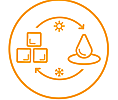
Document IIF
Utilisation de l'analyse thermogravimétrique pour l'étude de la dégradation des matériaux de stockage de l'énergie thermique : analyse de l'influence de l'évaporation.
On the use of TGA for the study of degradation of thermal energy storage materials: analysis of the influence of evaporation.
Numéro : 0008
Auteurs : GARCIA-OCINA E., DIARCE G.
Résumé
Selecting a thermal storage material requires consistent and predictable thermophysical properties. Thermogravimetric analysis (TGA) is a fundamental tool in study of the thermal behaviour of materials for energy storage. One of its main applications is the estimation of the thermal degradation of the materials by accelerated methods. However, evaporation has been observed as one of the main mechanisms of mass loss of some materials in TGA measurements, typically conducted in open crucibles. A commonly accepted solution to reduce the contribution of evaporation is the use of perforated lids. Nonetheless, placing a lid on the crucibles leads to severe difficulties in the quantification of evaporation. Therefore, a Computational Fluid Dynamics (CFD) model has been developed, based on the conditions of the specific TGA equipment. The use of this model enables the evaluation and quantification of the contribution of evaporation in real experiments, for both configurations, with and without a lid.
Documents disponibles
Format PDF
Pages : 6 p.
Disponible
Prix public
20 €
Prix membre*
Gratuit
* meilleur tarif applicable selon le type d'adhésion (voir le détail des avantages des adhésions individuelles et collectives)
Détails
- Titre original : On the use of TGA for the study of degradation of thermal energy storage materials: analysis of the influence of evaporation.
- Identifiant de la fiche : 30032360
- Langues : Anglais
- Sujet : Technologie
- Source : 14th IIR Conference on Phase-Change Materials and Slurries for Refrigeration and Air Conditioning. Proceedings: Paris France, May 29-31, 2024.
- Date d'édition : 31/05/2024
- DOI : http://dx.doi.org/10.18462/iir.pcm.2024.0008
Liens
Voir d'autres communications du même compte rendu (40)
Voir le compte rendu de la conférence
Indexation
-
Thèmes :
Stockage d'énergie thermique;
Frigoporteurs diphasiques (MCP, coulis de glace…) - Mots-clés : Modélisation; CFD; PCM; Évaporation; Alumine; Simulation
-
Development of novel hybrid battery thermal man...
- Auteurs : LEE S., LEE H.
- Date : 2022
- Langues : Anglais
- Source : 2022 Purdue Conferences. 19th International Refrigeration and Air-Conditioning Conference at Purdue.
- Formats : PDF
Voir la fiche
-
Influence of the stratification in a hot water ...
- Auteurs : IUNG A., SIMO TALA J. V., BAHRANI S. A., LAGARDERE DELEGLISE M.
- Date : 31/05/2024
- Langues : Anglais
- Source : 14th IIR Conference on Phase-Change Materials and Slurries for Refrigeration and Air Conditioning. Proceedings: Paris France, May 29-31, 2024.
- Formats : PDF
Voir la fiche
-
Optimization of Phase Change Thermal Energy Sto...
- Auteurs : LIU L., LIANG X.
- Date : 31/08/2021
- Langues : Anglais
- Source : 13th IEA Heat Pump Conference 2021: Heat Pumps – Mission for the Green World. Conference proceedings [full papers]
- Formats : PDF
Voir la fiche
-
Studying the solidification process of salt hyd...
- Auteurs : GUARDA D., MARTINEZ-GARCIA J., FENK B., GWERDER D., STAMATIOU A., WORLITSCHEK J., MANCIN S., SCHUETZ P.
- Date : 17/07/2024
- Langues : Anglais
- Source : 2024 Purdue Conferences. 20th International Refrigeration and Air-Conditioning Conference at Purdue.
- Formats : PDF
Voir la fiche
-
Numerical model calibration for composite-PCM L...
- Auteurs : NALDI C., DONGELLINI M., SALVI F., SILVESTRINI M., FALCONE M., MORINI G. L.
- Date : 01/09/2021
- Langues : Anglais
- Source : 13rd IIR Conference on Phase-Change Materials and Slurries for Refrigeration and Air Conditioning. Proceedings: (online) Vicenza, Italy, September 1-3, 2021.
- Formats : PDF
Voir la fiche
